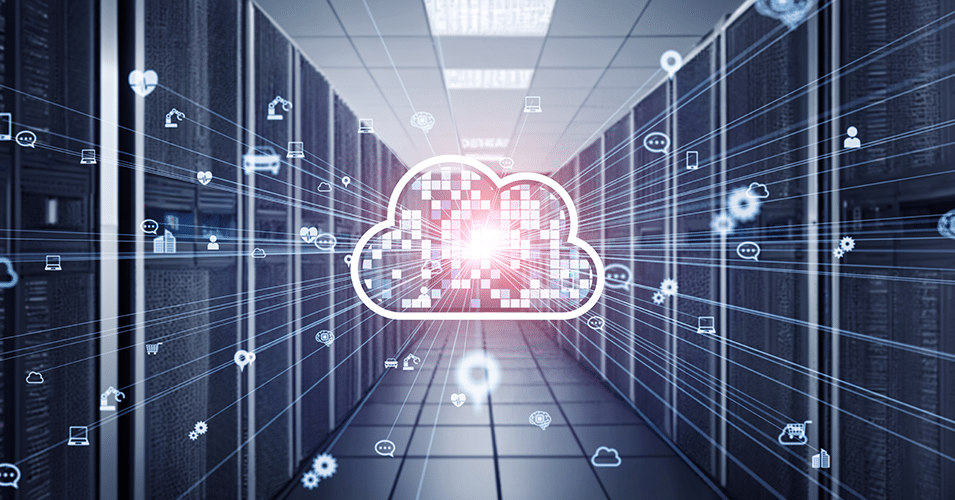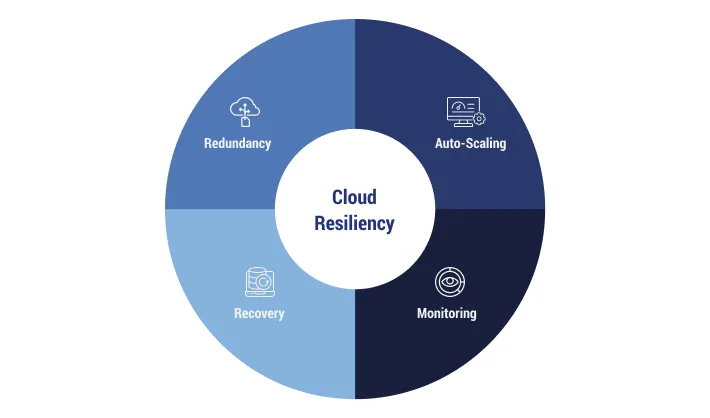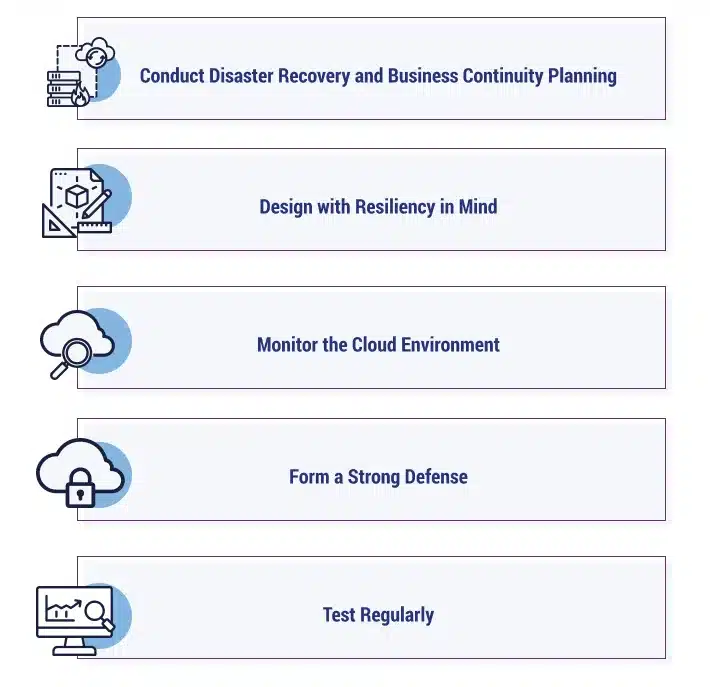June 27, 2023 | Channing Lovett
Ensuring Cloud Resiliency: Safeguarding Your Digital Assets

What’s standing between outside disruptions and your digital assets – a safe or a screen door? Businesses looking to achieve cloud resiliency need to think about the security of their systems, how well their organization can weather disruption, and what will happen to their digital assets when downtime occurs. We’ll talk about how organizations can ensure cloud resiliency and safeguard their digital assets, why it’s important, and best practices to follow.
What is Cloud Resiliency?
In simple terms, cloud resiliency is all about handling outages or disasters and returning operations to normal as efficiently as possible. Whether a business is faced with a natural disaster, hardware failure, human error, software issues, or cloud provider issues, cybercrime, a resilient system is one that keeps downtime and data loss minimal and helps meet restoration goals.
Why is Cloud Resiliency Important?
Cloud resiliency is important for multiple reasons. Most importantly, a resilient cloud environment will allow your business to get back to normal quickly. The speed at which data is recovered, and the amount of data that is lost between disruption and recovery, will have a ripple effect on the rest of the business, impacting everything from revenue and reputation to employee productivity and confidence in the organization. Keeping downtime low and data recovery high is critical.
Customers also have high expectations for accessibility and availability from businesses, which ties directly to cloud data resiliency. If a website or service is unavailable, even if it’s only for a brief period, certain customers may never return to that particular business.
Resiliency is also important from a regulatory standpoint. Some industries or types of business have requirements for uptime, availability, data retention, and data security. If they fail to meet these standards, there can be fines or other consequences associated with non-compliance.
How Do You Balance Speed and Data Security with Cloud Resiliency?
Speed and data security are two pieces that need to be in balance when talking about cloud resiliency. A secure cloud environment should retain as much data as is reasonable, but this needs to be done with enough speed so the business doesn’t suffer additional consequences from downtime.
For example, if a data center experienced an outage and the business got switched to the failover site in another city, businesses should consider speed and security in these ways:
- How fast does the switch occur? Does it take less than a minute, or does it take hours or days?
- How much data has been lost since the system went down and switched over? A few minutes or hours of data? Days?
Security goals need to be determined within the context of recovery point objectives (RPO) and recovery time objectives (RTO). A recovery point objective is a goal for how much data loss is acceptable during a disaster. If your business can afford to lose a few hours of data without experiencing a significant loss of revenue or productivity, your RPO might be 4 hours. For other businesses, this number could be much higher or lower. Some businesses can’t go more than 10 minutes before they desperately need their systems to be recovered, meaning their RTO might be 10 minutes. These objectives will depend on your industry and the nature of your data, but speed and security need to be considered together for this reason.
Resiliency and Cloud Availability
Another related topic to resiliency is cloud availability, which is expressed as a percentage of the amount of time an application is made available to an end-user. Most major cloud providers offer certain availability and uptime promises – for example, Amazon Web Services (AWS), Microsoft Azure, and Google Cloud Platform (GCP) all have a 99.9% availability service level agreement (SLA) for their services.
Choosing a cloud provider with high availability is one way to improve cloud resiliency.
Security in the Cloud vs. On-Premises
A big part of cloud resiliency is security in the cloud, which may be a new area for some businesses that are used to security controls in on-premises environments. In the past, organizations may have felt more secure with their sensitive data on-premises, but leading cloud providers often have more experience with security and stronger standards than most businesses.
When working with cloud security, organizations do need to be mindful of regulatory standards and ensure that cloud providers are meeting requirements for more stringent workloads, but they can often implement security measures that help maintain compliance and ensure businesses are protected from emerging threats.
Unless a business has precise requirements for security, or has a dedicated team with cybersecurity expertise, working with a cloud provider and other third-party security experts can improve resiliency compared to managing on-premises security. Organizations may also choose to adopt a private cloud environment for some workloads, offering increased security with the benefits of cloud architecture.
What Does Cloud Resiliency Entail?
Because the goal of cloud resiliency is to keep downtime and data loss to a minimum, the components of cloud resiliency should all contribute to that ultimate goal:

- Recovery: How resilient a cloud system is will depend on its ability to recover from disruption. Businesses should have recovery point objectives (RPO) and recovery time objectives (RTO) – how much data can the organization afford to lose, and how much time can pass before systems return to normal?
- Redundancy: Redundancy can be local to the site and an offsite location. Typically, if the main site goes down, resiliency means that there is a backup available elsewhere. Resilient cloud systems have a failover site in a geographically distinct location that will switch on when the primary site experiences downtime.
- Monitoring: Some potential disruptions can be discovered before they cause widespread issues. Resiliency is dependent on monitoring.
- Auto-Scaling: Businesses that experience fluctuations in demand also need a cloud system that can automatically scale as needed. If the demand is greater than the available resources, systems can go down, leaving customers, vendors, or employees without access.
Cloud Resiliency Best Practices
When trying to achieve cloud resiliency, businesses should follow these best practices:

Conduct Disaster Recovery and Business Continuity Planning
Recovering from a disaster is just one part of a bigger objective around business continuity – keeping your business operational through all business disruptions. Creating plans for disaster recovery and business continuity can help you identify potential roadblocks and outline the necessary steps and essential responsibilities for recovering and maintaining your systems.
Design with Resiliency in Mind
Part of disaster recovery and business continuity planning is designing your cloud environment with resiliency at the forefront. Your cloud environment should minimize disruptions, but not at the expense of scalability or performance. The design process should also consider utilizing Backup as a Service (BaaS) and Disaster Recovery as a Service (DRaaS) solutions, as well as cloud security solutions that protect data from incoming threats such as ransomware, malware, and data breaches.
Monitor the Cloud Environment
Cloud providers and third-party companies have cloud monitoring tools that can be used to keep an eye on performance and security in one cloud environment or across a hybrid or multicloud system. The more your organization is able to see, the better equipped you will be to defend against vulnerabilities and threats.
Form a Strong Defense
Preventative measures can build resiliency, such as regularly patching software bugs, implementing strong password and authentication methods and policies, and working with a reputable cloud provider that has a strong record of uptime and resiliency. Employees should also serve as a line of defense for the organization. Regularly train employees on cloud security matters, such as identifying phishing emails, reporting activity that is out of the norm, and using multi-factor authentication.
Test Regularly
You don’t want to be caught off-guard when you’re in the middle of a disaster. Test your recovery plans beforehand to ensure everything is working as expected. Performing a basic test, at least annually, can help bring you peace of mind that you’re covered.
Achieving Cloud Resiliency with a Managed Cloud Provider
Building business resiliency takes time and a unique set of skills. Even if you have some in-house expertise, working with a managed cloud provider can help you achieve robust resiliency, allowing you to shift your focus back to other business matters more quickly. TierPoint offers DRaaS, cloud services that maximize uptime and performance, business continuity services, and more to help you become more resilient.
Ready to master your resiliency and disaster recovery strategy? Download our planning and testing guide today to get started.
FAQs
With cloud resiliency, businesses can improve availability, reduce downtime, and cut down on business disruptions while improving their security and reducing costs associated with downtime or less resilient systems.
Reliability and resilience are closely related – reliability refers to the availability of a system and how long it can operate without being interrupted. Resilience is more concerned with how well a system is able to recover after experiencing a disruption.
AWS talks about cloud resiliency through the AWS Well-Architected framework, and considers not only the recovery itself, but the time it takes for the system to recover from load, attacks, or other failures.
Azure discusses platform resiliency, or the ability of Azure to recover when experiencing failures and return to a functioning state.

